Healthcare Communication Plan: Strategy for Better Patient Service
VerifiedAdded on 2023/06/11
|12
|3308
|65
Report
AI Summary
This report outlines a communication plan designed to address communication issues in a healthcare setting, specifically focusing on improving how staff respond to patient queries. The plan includes a stakeholder analysis, identifying both internal stakeholders like the Board of Directors, clinicians, staff, and auxiliary members, and external stakeholders such as patients, family members, residents, advisory committee members, municipal leaders, and the media. Strategies to overcome communication barriers involve employee training and education to enhance their communication skills and knowledge of organizational policies and programs. Key messages emphasize quality of service and organizational health, with communication channels tailored to each stakeholder group, including emails, newsletters, team meetings, social media, and notice boards. The plan's success relies on conveying the right messages through appropriate channels, requiring support from all stakeholders and aiming for implementation within three to six months. This document is available on Desklib, a platform offering AI-based study tools and a variety of academic resources for students.
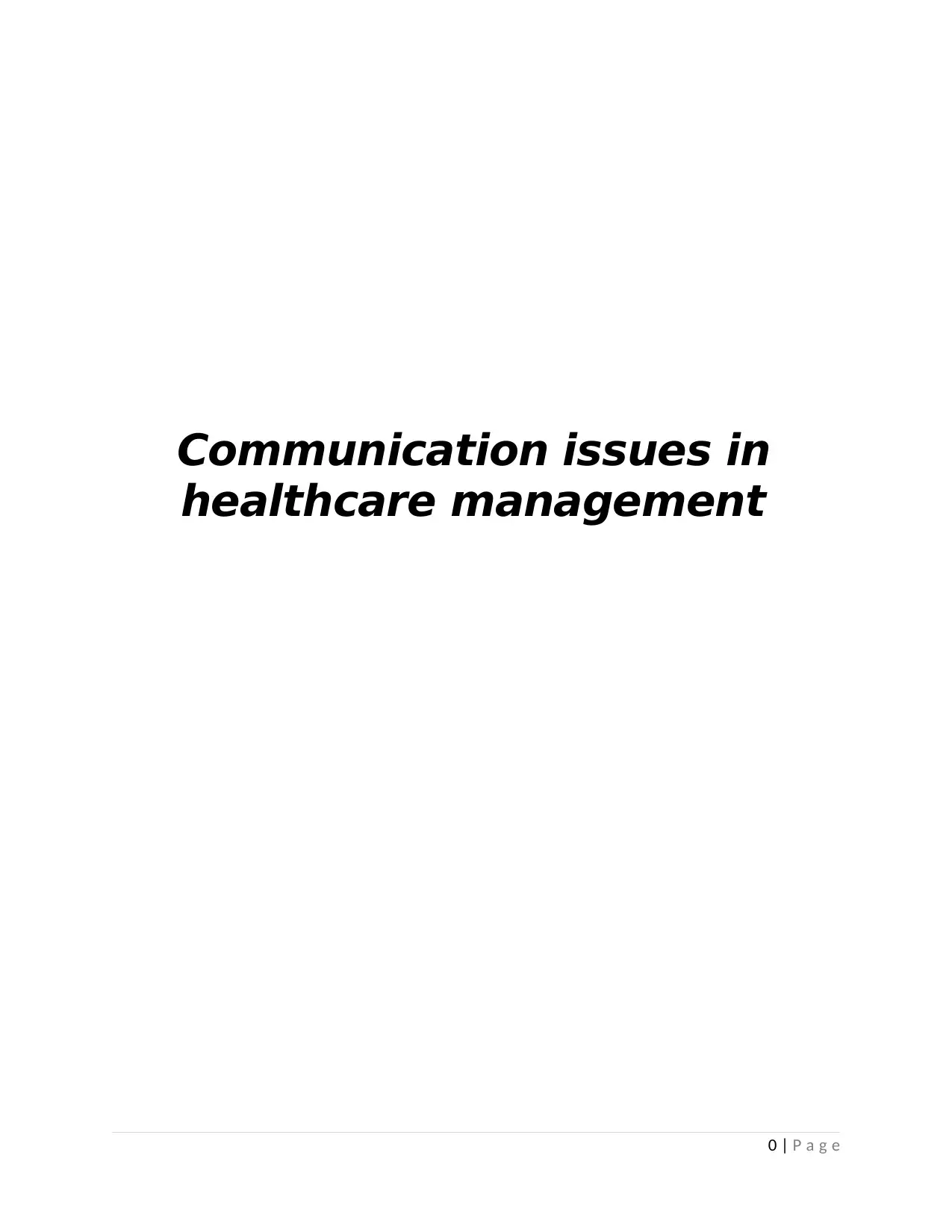
Communication issues in
healthcare management
0 | P a g e
healthcare management
0 | P a g e
Paraphrase This Document
Need a fresh take? Get an instant paraphrase of this document with our AI Paraphraser
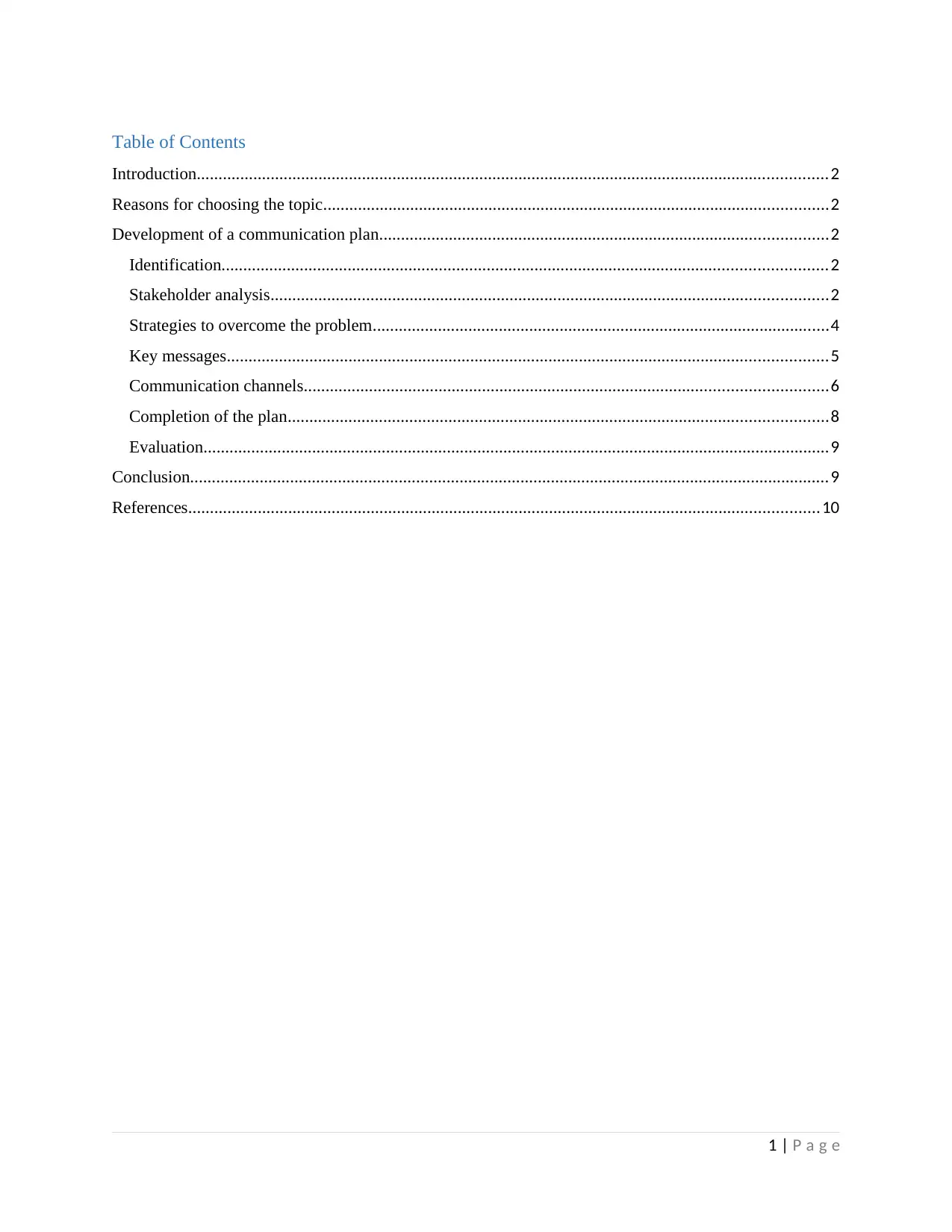
Table of Contents
Introduction.................................................................................................................................................2
Reasons for choosing the topic....................................................................................................................2
Development of a communication plan.......................................................................................................2
Identification...........................................................................................................................................2
Stakeholder analysis................................................................................................................................2
Strategies to overcome the problem.........................................................................................................4
Key messages..........................................................................................................................................5
Communication channels........................................................................................................................6
Completion of the plan............................................................................................................................8
Evaluation................................................................................................................................................9
Conclusion...................................................................................................................................................9
References.................................................................................................................................................10
1 | P a g e
Introduction.................................................................................................................................................2
Reasons for choosing the topic....................................................................................................................2
Development of a communication plan.......................................................................................................2
Identification...........................................................................................................................................2
Stakeholder analysis................................................................................................................................2
Strategies to overcome the problem.........................................................................................................4
Key messages..........................................................................................................................................5
Communication channels........................................................................................................................6
Completion of the plan............................................................................................................................8
Evaluation................................................................................................................................................9
Conclusion...................................................................................................................................................9
References.................................................................................................................................................10
1 | P a g e
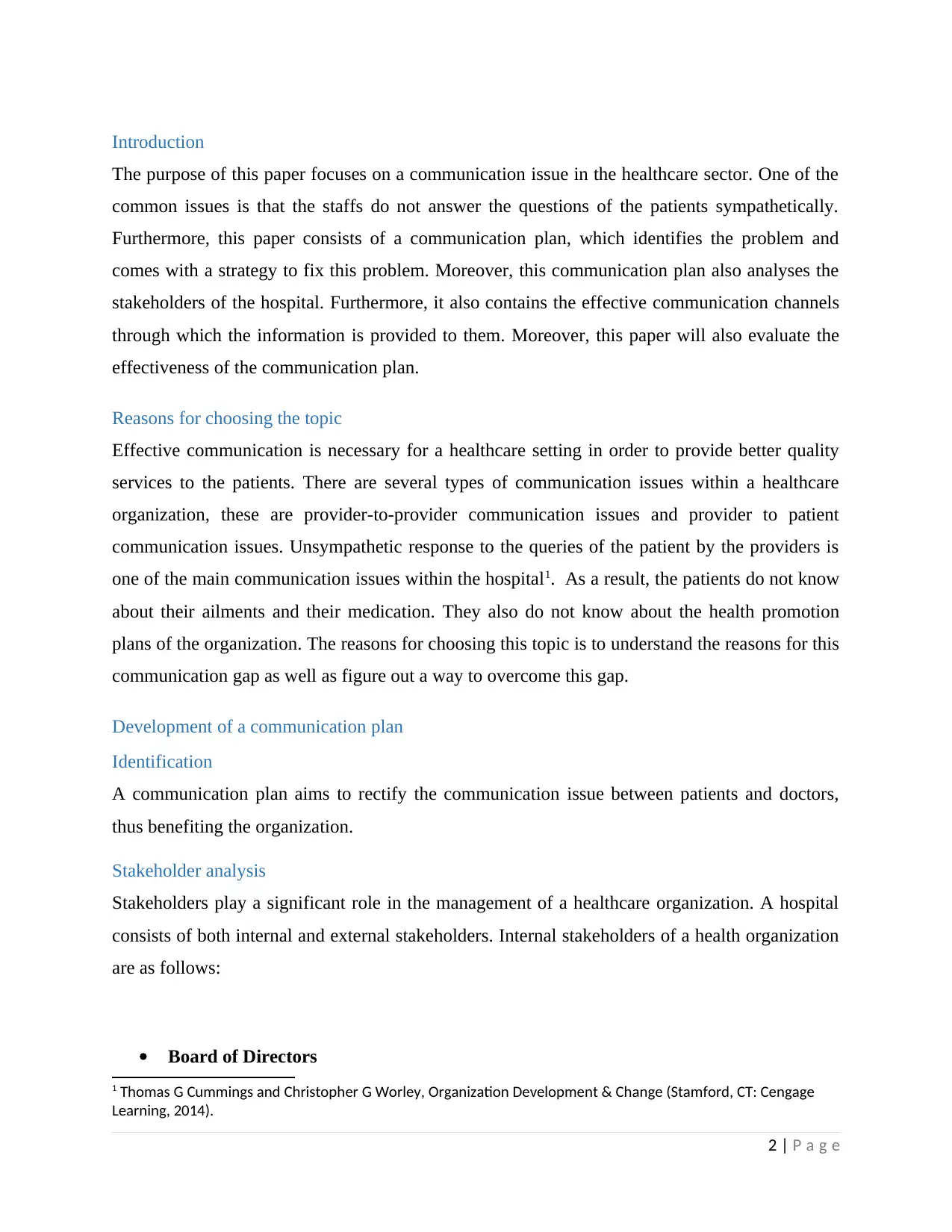
Introduction
The purpose of this paper focuses on a communication issue in the healthcare sector. One of the
common issues is that the staffs do not answer the questions of the patients sympathetically.
Furthermore, this paper consists of a communication plan, which identifies the problem and
comes with a strategy to fix this problem. Moreover, this communication plan also analyses the
stakeholders of the hospital. Furthermore, it also contains the effective communication channels
through which the information is provided to them. Moreover, this paper will also evaluate the
effectiveness of the communication plan.
Reasons for choosing the topic
Effective communication is necessary for a healthcare setting in order to provide better quality
services to the patients. There are several types of communication issues within a healthcare
organization, these are provider-to-provider communication issues and provider to patient
communication issues. Unsympathetic response to the queries of the patient by the providers is
one of the main communication issues within the hospital1. As a result, the patients do not know
about their ailments and their medication. They also do not know about the health promotion
plans of the organization. The reasons for choosing this topic is to understand the reasons for this
communication gap as well as figure out a way to overcome this gap.
Development of a communication plan
Identification
A communication plan aims to rectify the communication issue between patients and doctors,
thus benefiting the organization.
Stakeholder analysis
Stakeholders play a significant role in the management of a healthcare organization. A hospital
consists of both internal and external stakeholders. Internal stakeholders of a health organization
are as follows:
Board of Directors
1 Thomas G Cummings and Christopher G Worley, Organization Development & Change (Stamford, CT: Cengage
Learning, 2014).
2 | P a g e
The purpose of this paper focuses on a communication issue in the healthcare sector. One of the
common issues is that the staffs do not answer the questions of the patients sympathetically.
Furthermore, this paper consists of a communication plan, which identifies the problem and
comes with a strategy to fix this problem. Moreover, this communication plan also analyses the
stakeholders of the hospital. Furthermore, it also contains the effective communication channels
through which the information is provided to them. Moreover, this paper will also evaluate the
effectiveness of the communication plan.
Reasons for choosing the topic
Effective communication is necessary for a healthcare setting in order to provide better quality
services to the patients. There are several types of communication issues within a healthcare
organization, these are provider-to-provider communication issues and provider to patient
communication issues. Unsympathetic response to the queries of the patient by the providers is
one of the main communication issues within the hospital1. As a result, the patients do not know
about their ailments and their medication. They also do not know about the health promotion
plans of the organization. The reasons for choosing this topic is to understand the reasons for this
communication gap as well as figure out a way to overcome this gap.
Development of a communication plan
Identification
A communication plan aims to rectify the communication issue between patients and doctors,
thus benefiting the organization.
Stakeholder analysis
Stakeholders play a significant role in the management of a healthcare organization. A hospital
consists of both internal and external stakeholders. Internal stakeholders of a health organization
are as follows:
Board of Directors
1 Thomas G Cummings and Christopher G Worley, Organization Development & Change (Stamford, CT: Cengage
Learning, 2014).
2 | P a g e
⊘ This is a preview!⊘
Do you want full access?
Subscribe today to unlock all pages.

Trusted by 1+ million students worldwide
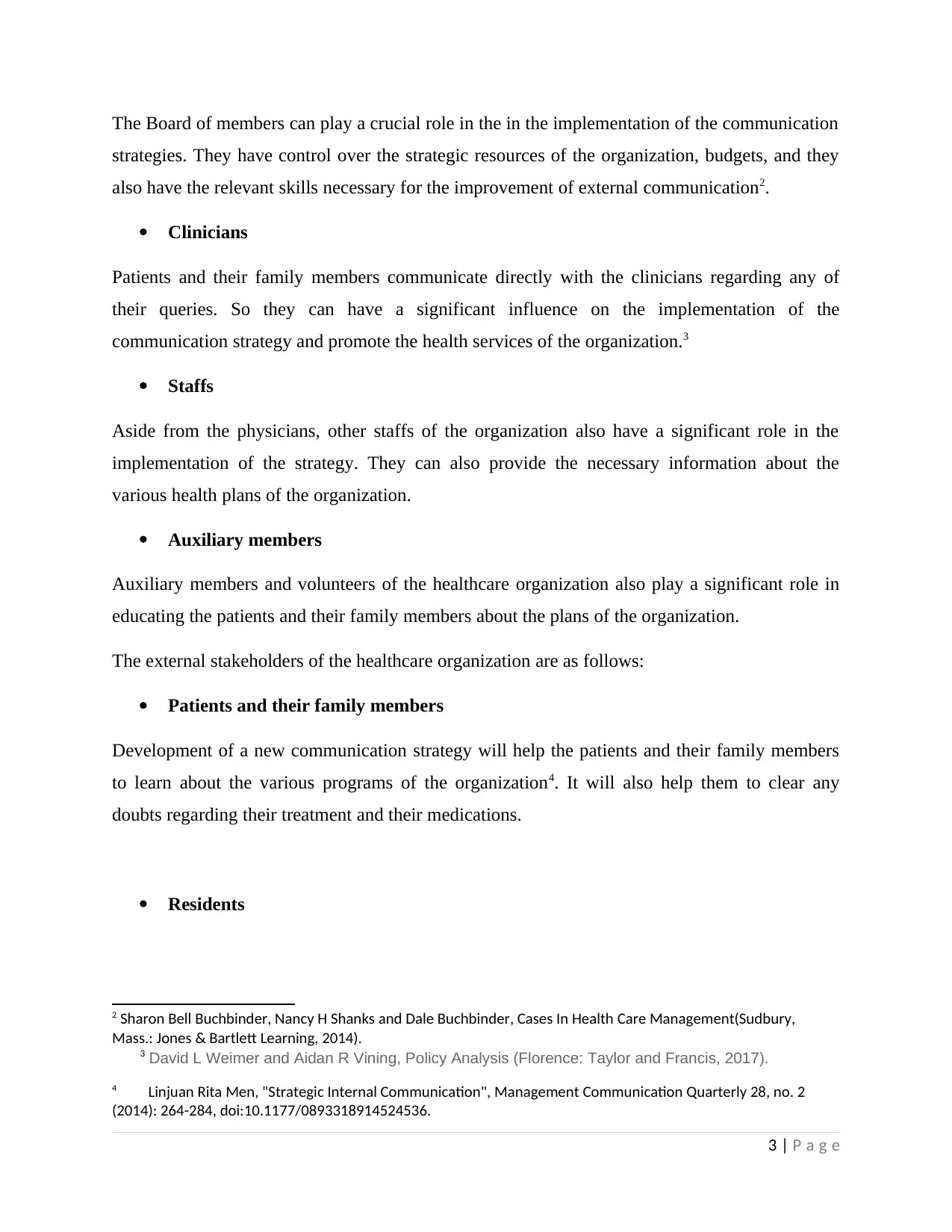
The Board of members can play a crucial role in the in the implementation of the communication
strategies. They have control over the strategic resources of the organization, budgets, and they
also have the relevant skills necessary for the improvement of external communication2.
Clinicians
Patients and their family members communicate directly with the clinicians regarding any of
their queries. So they can have a significant influence on the implementation of the
communication strategy and promote the health services of the organization.3
Staffs
Aside from the physicians, other staffs of the organization also have a significant role in the
implementation of the strategy. They can also provide the necessary information about the
various health plans of the organization.
Auxiliary members
Auxiliary members and volunteers of the healthcare organization also play a significant role in
educating the patients and their family members about the plans of the organization.
The external stakeholders of the healthcare organization are as follows:
Patients and their family members
Development of a new communication strategy will help the patients and their family members
to learn about the various programs of the organization4. It will also help them to clear any
doubts regarding their treatment and their medications.
Residents
2 Sharon Bell Buchbinder, Nancy H Shanks and Dale Buchbinder, Cases In Health Care Management(Sudbury,
Mass.: Jones & Bartlett Learning, 2014).
3 David L Weimer and Aidan R Vining, Policy Analysis (Florence: Taylor and Francis, 2017).
4 Linjuan Rita Men, "Strategic Internal Communication", Management Communication Quarterly 28, no. 2
(2014): 264-284, doi:10.1177/0893318914524536.
3 | P a g e
strategies. They have control over the strategic resources of the organization, budgets, and they
also have the relevant skills necessary for the improvement of external communication2.
Clinicians
Patients and their family members communicate directly with the clinicians regarding any of
their queries. So they can have a significant influence on the implementation of the
communication strategy and promote the health services of the organization.3
Staffs
Aside from the physicians, other staffs of the organization also have a significant role in the
implementation of the strategy. They can also provide the necessary information about the
various health plans of the organization.
Auxiliary members
Auxiliary members and volunteers of the healthcare organization also play a significant role in
educating the patients and their family members about the plans of the organization.
The external stakeholders of the healthcare organization are as follows:
Patients and their family members
Development of a new communication strategy will help the patients and their family members
to learn about the various programs of the organization4. It will also help them to clear any
doubts regarding their treatment and their medications.
Residents
2 Sharon Bell Buchbinder, Nancy H Shanks and Dale Buchbinder, Cases In Health Care Management(Sudbury,
Mass.: Jones & Bartlett Learning, 2014).
3 David L Weimer and Aidan R Vining, Policy Analysis (Florence: Taylor and Francis, 2017).
4 Linjuan Rita Men, "Strategic Internal Communication", Management Communication Quarterly 28, no. 2
(2014): 264-284, doi:10.1177/0893318914524536.
3 | P a g e
Paraphrase This Document
Need a fresh take? Get an instant paraphrase of this document with our AI Paraphraser
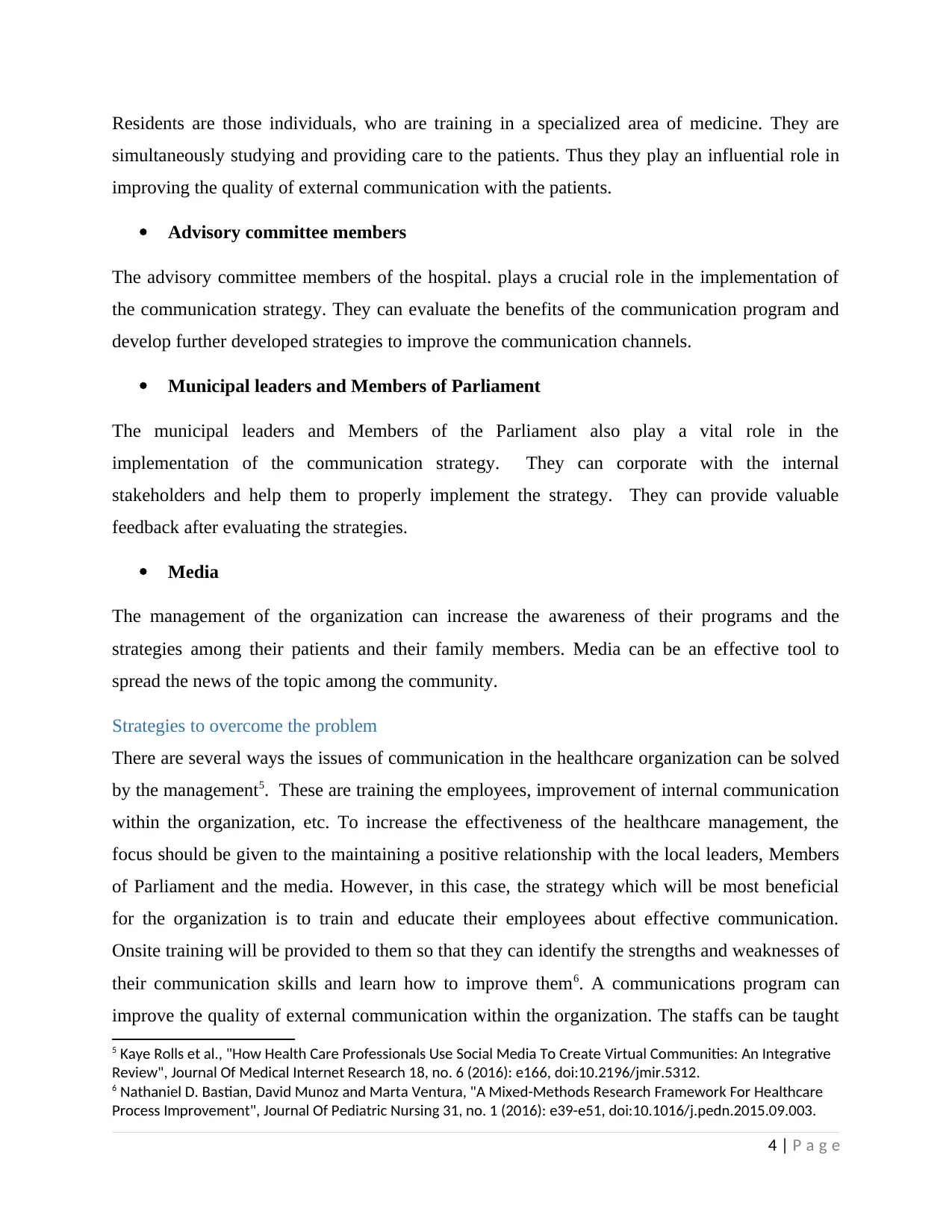
Residents are those individuals, who are training in a specialized area of medicine. They are
simultaneously studying and providing care to the patients. Thus they play an influential role in
improving the quality of external communication with the patients.
Advisory committee members
The advisory committee members of the hospital. plays a crucial role in the implementation of
the communication strategy. They can evaluate the benefits of the communication program and
develop further developed strategies to improve the communication channels.
Municipal leaders and Members of Parliament
The municipal leaders and Members of the Parliament also play a vital role in the
implementation of the communication strategy. They can corporate with the internal
stakeholders and help them to properly implement the strategy. They can provide valuable
feedback after evaluating the strategies.
Media
The management of the organization can increase the awareness of their programs and the
strategies among their patients and their family members. Media can be an effective tool to
spread the news of the topic among the community.
Strategies to overcome the problem
There are several ways the issues of communication in the healthcare organization can be solved
by the management5. These are training the employees, improvement of internal communication
within the organization, etc. To increase the effectiveness of the healthcare management, the
focus should be given to the maintaining a positive relationship with the local leaders, Members
of Parliament and the media. However, in this case, the strategy which will be most beneficial
for the organization is to train and educate their employees about effective communication.
Onsite training will be provided to them so that they can identify the strengths and weaknesses of
their communication skills and learn how to improve them6. A communications program can
improve the quality of external communication within the organization. The staffs can be taught
5 Kaye Rolls et al., "How Health Care Professionals Use Social Media To Create Virtual Communities: An Integrative
Review", Journal Of Medical Internet Research 18, no. 6 (2016): e166, doi:10.2196/jmir.5312.
6 Nathaniel D. Bastian, David Munoz and Marta Ventura, "A Mixed-Methods Research Framework For Healthcare
Process Improvement", Journal Of Pediatric Nursing 31, no. 1 (2016): e39-e51, doi:10.1016/j.pedn.2015.09.003.
4 | P a g e
simultaneously studying and providing care to the patients. Thus they play an influential role in
improving the quality of external communication with the patients.
Advisory committee members
The advisory committee members of the hospital. plays a crucial role in the implementation of
the communication strategy. They can evaluate the benefits of the communication program and
develop further developed strategies to improve the communication channels.
Municipal leaders and Members of Parliament
The municipal leaders and Members of the Parliament also play a vital role in the
implementation of the communication strategy. They can corporate with the internal
stakeholders and help them to properly implement the strategy. They can provide valuable
feedback after evaluating the strategies.
Media
The management of the organization can increase the awareness of their programs and the
strategies among their patients and their family members. Media can be an effective tool to
spread the news of the topic among the community.
Strategies to overcome the problem
There are several ways the issues of communication in the healthcare organization can be solved
by the management5. These are training the employees, improvement of internal communication
within the organization, etc. To increase the effectiveness of the healthcare management, the
focus should be given to the maintaining a positive relationship with the local leaders, Members
of Parliament and the media. However, in this case, the strategy which will be most beneficial
for the organization is to train and educate their employees about effective communication.
Onsite training will be provided to them so that they can identify the strengths and weaknesses of
their communication skills and learn how to improve them6. A communications program can
improve the quality of external communication within the organization. The staffs can be taught
5 Kaye Rolls et al., "How Health Care Professionals Use Social Media To Create Virtual Communities: An Integrative
Review", Journal Of Medical Internet Research 18, no. 6 (2016): e166, doi:10.2196/jmir.5312.
6 Nathaniel D. Bastian, David Munoz and Marta Ventura, "A Mixed-Methods Research Framework For Healthcare
Process Improvement", Journal Of Pediatric Nursing 31, no. 1 (2016): e39-e51, doi:10.1016/j.pedn.2015.09.003.
4 | P a g e
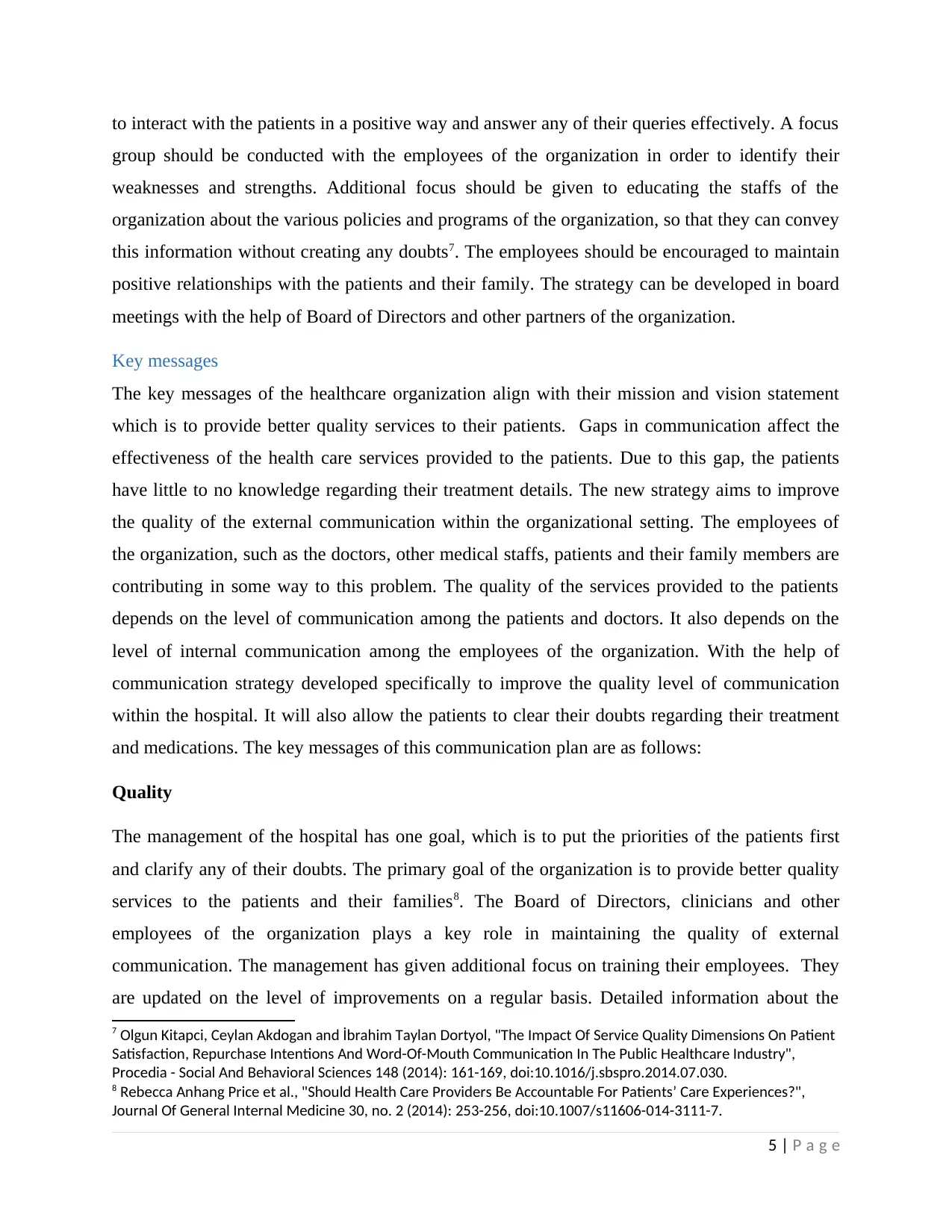
to interact with the patients in a positive way and answer any of their queries effectively. A focus
group should be conducted with the employees of the organization in order to identify their
weaknesses and strengths. Additional focus should be given to educating the staffs of the
organization about the various policies and programs of the organization, so that they can convey
this information without creating any doubts7. The employees should be encouraged to maintain
positive relationships with the patients and their family. The strategy can be developed in board
meetings with the help of Board of Directors and other partners of the organization.
Key messages
The key messages of the healthcare organization align with their mission and vision statement
which is to provide better quality services to their patients. Gaps in communication affect the
effectiveness of the health care services provided to the patients. Due to this gap, the patients
have little to no knowledge regarding their treatment details. The new strategy aims to improve
the quality of the external communication within the organizational setting. The employees of
the organization, such as the doctors, other medical staffs, patients and their family members are
contributing in some way to this problem. The quality of the services provided to the patients
depends on the level of communication among the patients and doctors. It also depends on the
level of internal communication among the employees of the organization. With the help of
communication strategy developed specifically to improve the quality level of communication
within the hospital. It will also allow the patients to clear their doubts regarding their treatment
and medications. The key messages of this communication plan are as follows:
Quality
The management of the hospital has one goal, which is to put the priorities of the patients first
and clarify any of their doubts. The primary goal of the organization is to provide better quality
services to the patients and their families8. The Board of Directors, clinicians and other
employees of the organization plays a key role in maintaining the quality of external
communication. The management has given additional focus on training their employees. They
are updated on the level of improvements on a regular basis. Detailed information about the
7 Olgun Kitapci, Ceylan Akdogan and İbrahim Taylan Dortyol, "The Impact Of Service Quality Dimensions On Patient
Satisfaction, Repurchase Intentions And Word-Of-Mouth Communication In The Public Healthcare Industry",
Procedia - Social And Behavioral Sciences 148 (2014): 161-169, doi:10.1016/j.sbspro.2014.07.030.
8 Rebecca Anhang Price et al., "Should Health Care Providers Be Accountable For Patients’ Care Experiences?",
Journal Of General Internal Medicine 30, no. 2 (2014): 253-256, doi:10.1007/s11606-014-3111-7.
5 | P a g e
group should be conducted with the employees of the organization in order to identify their
weaknesses and strengths. Additional focus should be given to educating the staffs of the
organization about the various policies and programs of the organization, so that they can convey
this information without creating any doubts7. The employees should be encouraged to maintain
positive relationships with the patients and their family. The strategy can be developed in board
meetings with the help of Board of Directors and other partners of the organization.
Key messages
The key messages of the healthcare organization align with their mission and vision statement
which is to provide better quality services to their patients. Gaps in communication affect the
effectiveness of the health care services provided to the patients. Due to this gap, the patients
have little to no knowledge regarding their treatment details. The new strategy aims to improve
the quality of the external communication within the organizational setting. The employees of
the organization, such as the doctors, other medical staffs, patients and their family members are
contributing in some way to this problem. The quality of the services provided to the patients
depends on the level of communication among the patients and doctors. It also depends on the
level of internal communication among the employees of the organization. With the help of
communication strategy developed specifically to improve the quality level of communication
within the hospital. It will also allow the patients to clear their doubts regarding their treatment
and medications. The key messages of this communication plan are as follows:
Quality
The management of the hospital has one goal, which is to put the priorities of the patients first
and clarify any of their doubts. The primary goal of the organization is to provide better quality
services to the patients and their families8. The Board of Directors, clinicians and other
employees of the organization plays a key role in maintaining the quality of external
communication. The management has given additional focus on training their employees. They
are updated on the level of improvements on a regular basis. Detailed information about the
7 Olgun Kitapci, Ceylan Akdogan and İbrahim Taylan Dortyol, "The Impact Of Service Quality Dimensions On Patient
Satisfaction, Repurchase Intentions And Word-Of-Mouth Communication In The Public Healthcare Industry",
Procedia - Social And Behavioral Sciences 148 (2014): 161-169, doi:10.1016/j.sbspro.2014.07.030.
8 Rebecca Anhang Price et al., "Should Health Care Providers Be Accountable For Patients’ Care Experiences?",
Journal Of General Internal Medicine 30, no. 2 (2014): 253-256, doi:10.1007/s11606-014-3111-7.
5 | P a g e
⊘ This is a preview!⊘
Do you want full access?
Subscribe today to unlock all pages.

Trusted by 1+ million students worldwide
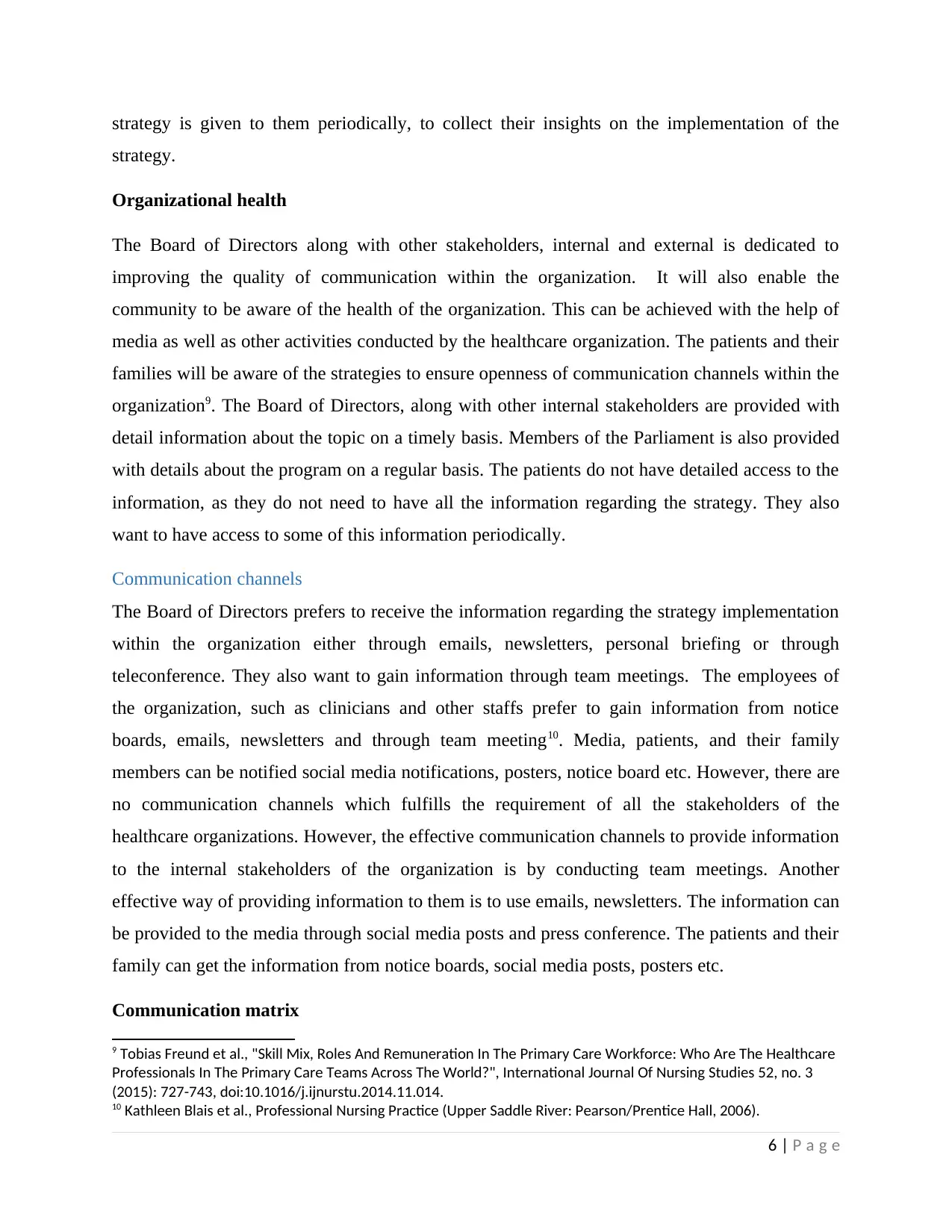
strategy is given to them periodically, to collect their insights on the implementation of the
strategy.
Organizational health
The Board of Directors along with other stakeholders, internal and external is dedicated to
improving the quality of communication within the organization. It will also enable the
community to be aware of the health of the organization. This can be achieved with the help of
media as well as other activities conducted by the healthcare organization. The patients and their
families will be aware of the strategies to ensure openness of communication channels within the
organization9. The Board of Directors, along with other internal stakeholders are provided with
detail information about the topic on a timely basis. Members of the Parliament is also provided
with details about the program on a regular basis. The patients do not have detailed access to the
information, as they do not need to have all the information regarding the strategy. They also
want to have access to some of this information periodically.
Communication channels
The Board of Directors prefers to receive the information regarding the strategy implementation
within the organization either through emails, newsletters, personal briefing or through
teleconference. They also want to gain information through team meetings. The employees of
the organization, such as clinicians and other staffs prefer to gain information from notice
boards, emails, newsletters and through team meeting10. Media, patients, and their family
members can be notified social media notifications, posters, notice board etc. However, there are
no communication channels which fulfills the requirement of all the stakeholders of the
healthcare organizations. However, the effective communication channels to provide information
to the internal stakeholders of the organization is by conducting team meetings. Another
effective way of providing information to them is to use emails, newsletters. The information can
be provided to the media through social media posts and press conference. The patients and their
family can get the information from notice boards, social media posts, posters etc.
Communication matrix
9 Tobias Freund et al., "Skill Mix, Roles And Remuneration In The Primary Care Workforce: Who Are The Healthcare
Professionals In The Primary Care Teams Across The World?", International Journal Of Nursing Studies 52, no. 3
(2015): 727-743, doi:10.1016/j.ijnurstu.2014.11.014.
10 Kathleen Blais et al., Professional Nursing Practice (Upper Saddle River: Pearson/Prentice Hall, 2006).
6 | P a g e
strategy.
Organizational health
The Board of Directors along with other stakeholders, internal and external is dedicated to
improving the quality of communication within the organization. It will also enable the
community to be aware of the health of the organization. This can be achieved with the help of
media as well as other activities conducted by the healthcare organization. The patients and their
families will be aware of the strategies to ensure openness of communication channels within the
organization9. The Board of Directors, along with other internal stakeholders are provided with
detail information about the topic on a timely basis. Members of the Parliament is also provided
with details about the program on a regular basis. The patients do not have detailed access to the
information, as they do not need to have all the information regarding the strategy. They also
want to have access to some of this information periodically.
Communication channels
The Board of Directors prefers to receive the information regarding the strategy implementation
within the organization either through emails, newsletters, personal briefing or through
teleconference. They also want to gain information through team meetings. The employees of
the organization, such as clinicians and other staffs prefer to gain information from notice
boards, emails, newsletters and through team meeting10. Media, patients, and their family
members can be notified social media notifications, posters, notice board etc. However, there are
no communication channels which fulfills the requirement of all the stakeholders of the
healthcare organizations. However, the effective communication channels to provide information
to the internal stakeholders of the organization is by conducting team meetings. Another
effective way of providing information to them is to use emails, newsletters. The information can
be provided to the media through social media posts and press conference. The patients and their
family can get the information from notice boards, social media posts, posters etc.
Communication matrix
9 Tobias Freund et al., "Skill Mix, Roles And Remuneration In The Primary Care Workforce: Who Are The Healthcare
Professionals In The Primary Care Teams Across The World?", International Journal Of Nursing Studies 52, no. 3
(2015): 727-743, doi:10.1016/j.ijnurstu.2014.11.014.
10 Kathleen Blais et al., Professional Nursing Practice (Upper Saddle River: Pearson/Prentice Hall, 2006).
6 | P a g e
Paraphrase This Document
Need a fresh take? Get an instant paraphrase of this document with our AI Paraphraser
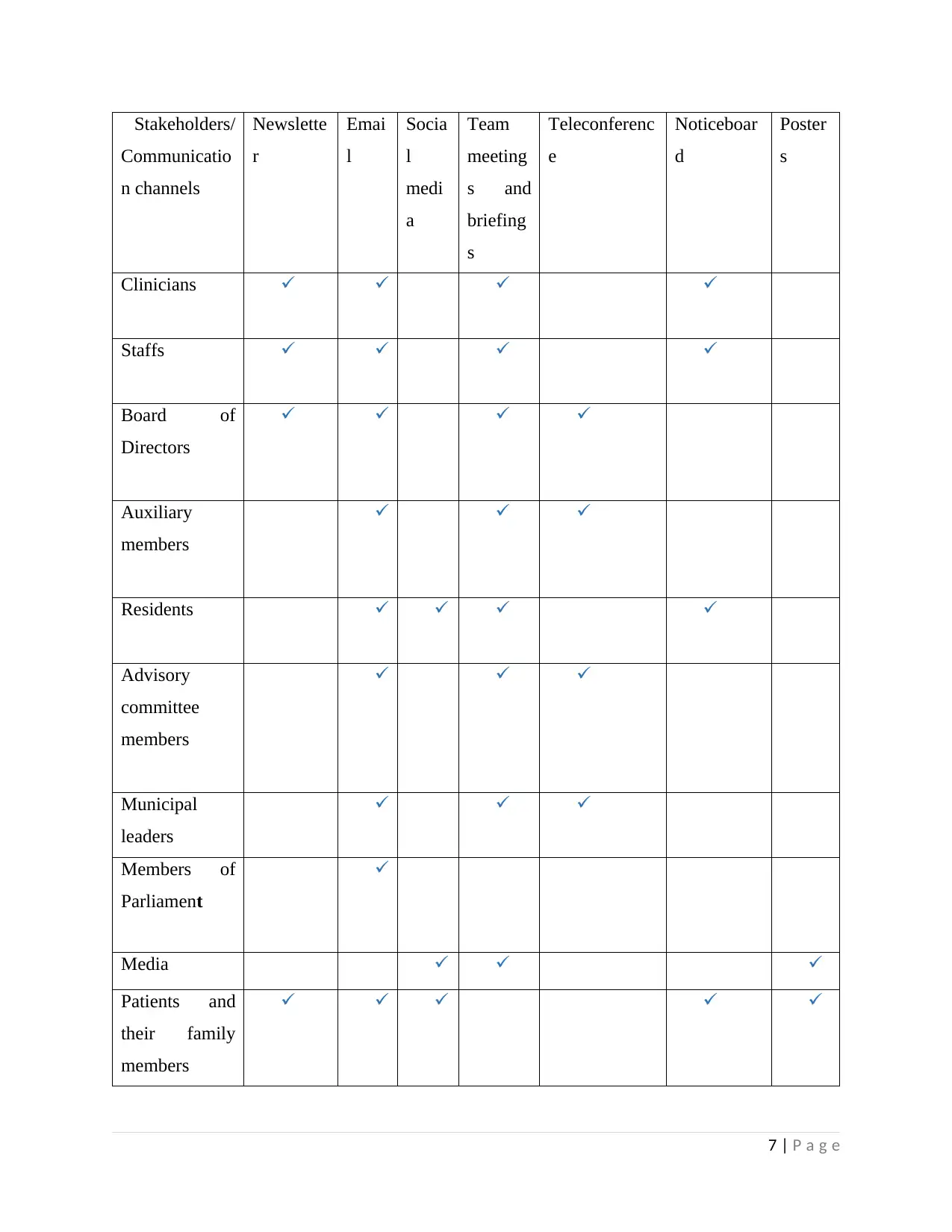
Stakeholders/
Communicatio
n channels
Newslette
r
Emai
l
Socia
l
medi
a
Team
meeting
s and
briefing
s
Teleconferenc
e
Noticeboar
d
Poster
s
Clinicians
Staffs
Board of
Directors
Auxiliary
members
Residents
Advisory
committee
members
Municipal
leaders
Members of
Parliament
Media
Patients and
their family
members
7 | P a g e
Communicatio
n channels
Newslette
r
Emai
l
Socia
l
medi
a
Team
meeting
s and
briefing
s
Teleconferenc
e
Noticeboar
d
Poster
s
Clinicians
Staffs
Board of
Directors
Auxiliary
members
Residents
Advisory
committee
members
Municipal
leaders
Members of
Parliament
Media
Patients and
their family
members
7 | P a g e
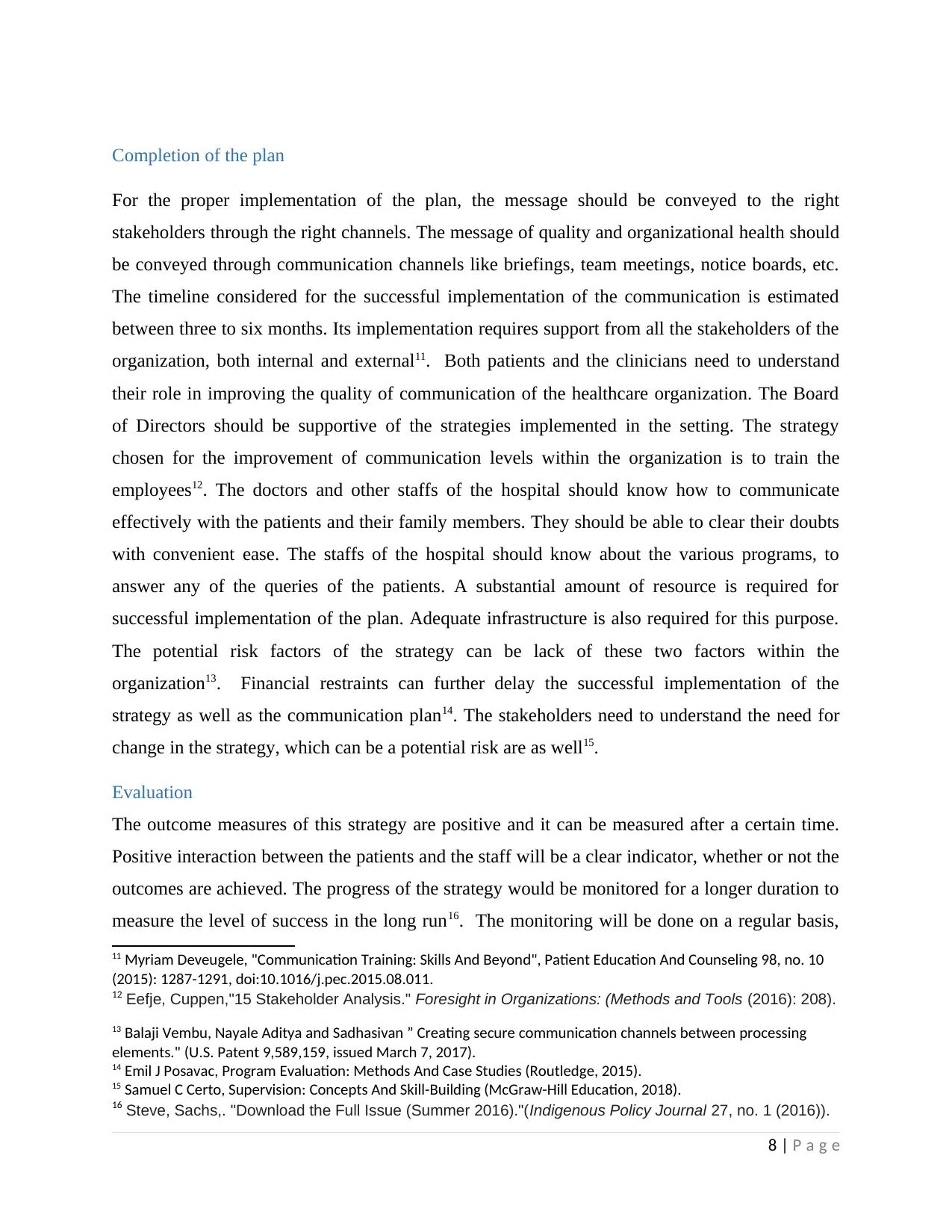
Completion of the plan
For the proper implementation of the plan, the message should be conveyed to the right
stakeholders through the right channels. The message of quality and organizational health should
be conveyed through communication channels like briefings, team meetings, notice boards, etc.
The timeline considered for the successful implementation of the communication is estimated
between three to six months. Its implementation requires support from all the stakeholders of the
organization, both internal and external11. Both patients and the clinicians need to understand
their role in improving the quality of communication of the healthcare organization. The Board
of Directors should be supportive of the strategies implemented in the setting. The strategy
chosen for the improvement of communication levels within the organization is to train the
employees12. The doctors and other staffs of the hospital should know how to communicate
effectively with the patients and their family members. They should be able to clear their doubts
with convenient ease. The staffs of the hospital should know about the various programs, to
answer any of the queries of the patients. A substantial amount of resource is required for
successful implementation of the plan. Adequate infrastructure is also required for this purpose.
The potential risk factors of the strategy can be lack of these two factors within the
organization13. Financial restraints can further delay the successful implementation of the
strategy as well as the communication plan14. The stakeholders need to understand the need for
change in the strategy, which can be a potential risk are as well15.
Evaluation
The outcome measures of this strategy are positive and it can be measured after a certain time.
Positive interaction between the patients and the staff will be a clear indicator, whether or not the
outcomes are achieved. The progress of the strategy would be monitored for a longer duration to
measure the level of success in the long run16. The monitoring will be done on a regular basis,
11 Myriam Deveugele, "Communication Training: Skills And Beyond", Patient Education And Counseling 98, no. 10
(2015): 1287-1291, doi:10.1016/j.pec.2015.08.011.
12 Eefje, Cuppen,"15 Stakeholder Analysis." Foresight in Organizations: (Methods and Tools (2016): 208).
13 Balaji Vembu, Nayale Aditya and Sadhasivan ” Creating secure communication channels between processing
elements." (U.S. Patent 9,589,159, issued March 7, 2017).
14 Emil J Posavac, Program Evaluation: Methods And Case Studies (Routledge, 2015).
15 Samuel C Certo, Supervision: Concepts And Skill-Building (McGraw-Hill Education, 2018).
16 Steve, Sachs,. "Download the Full Issue (Summer 2016)."(Indigenous Policy Journal 27, no. 1 (2016)).
8 | P a g e
For the proper implementation of the plan, the message should be conveyed to the right
stakeholders through the right channels. The message of quality and organizational health should
be conveyed through communication channels like briefings, team meetings, notice boards, etc.
The timeline considered for the successful implementation of the communication is estimated
between three to six months. Its implementation requires support from all the stakeholders of the
organization, both internal and external11. Both patients and the clinicians need to understand
their role in improving the quality of communication of the healthcare organization. The Board
of Directors should be supportive of the strategies implemented in the setting. The strategy
chosen for the improvement of communication levels within the organization is to train the
employees12. The doctors and other staffs of the hospital should know how to communicate
effectively with the patients and their family members. They should be able to clear their doubts
with convenient ease. The staffs of the hospital should know about the various programs, to
answer any of the queries of the patients. A substantial amount of resource is required for
successful implementation of the plan. Adequate infrastructure is also required for this purpose.
The potential risk factors of the strategy can be lack of these two factors within the
organization13. Financial restraints can further delay the successful implementation of the
strategy as well as the communication plan14. The stakeholders need to understand the need for
change in the strategy, which can be a potential risk are as well15.
Evaluation
The outcome measures of this strategy are positive and it can be measured after a certain time.
Positive interaction between the patients and the staff will be a clear indicator, whether or not the
outcomes are achieved. The progress of the strategy would be monitored for a longer duration to
measure the level of success in the long run16. The monitoring will be done on a regular basis,
11 Myriam Deveugele, "Communication Training: Skills And Beyond", Patient Education And Counseling 98, no. 10
(2015): 1287-1291, doi:10.1016/j.pec.2015.08.011.
12 Eefje, Cuppen,"15 Stakeholder Analysis." Foresight in Organizations: (Methods and Tools (2016): 208).
13 Balaji Vembu, Nayale Aditya and Sadhasivan ” Creating secure communication channels between processing
elements." (U.S. Patent 9,589,159, issued March 7, 2017).
14 Emil J Posavac, Program Evaluation: Methods And Case Studies (Routledge, 2015).
15 Samuel C Certo, Supervision: Concepts And Skill-Building (McGraw-Hill Education, 2018).
16 Steve, Sachs,. "Download the Full Issue (Summer 2016)."(Indigenous Policy Journal 27, no. 1 (2016)).
8 | P a g e
⊘ This is a preview!⊘
Do you want full access?
Subscribe today to unlock all pages.

Trusted by 1+ million students worldwide
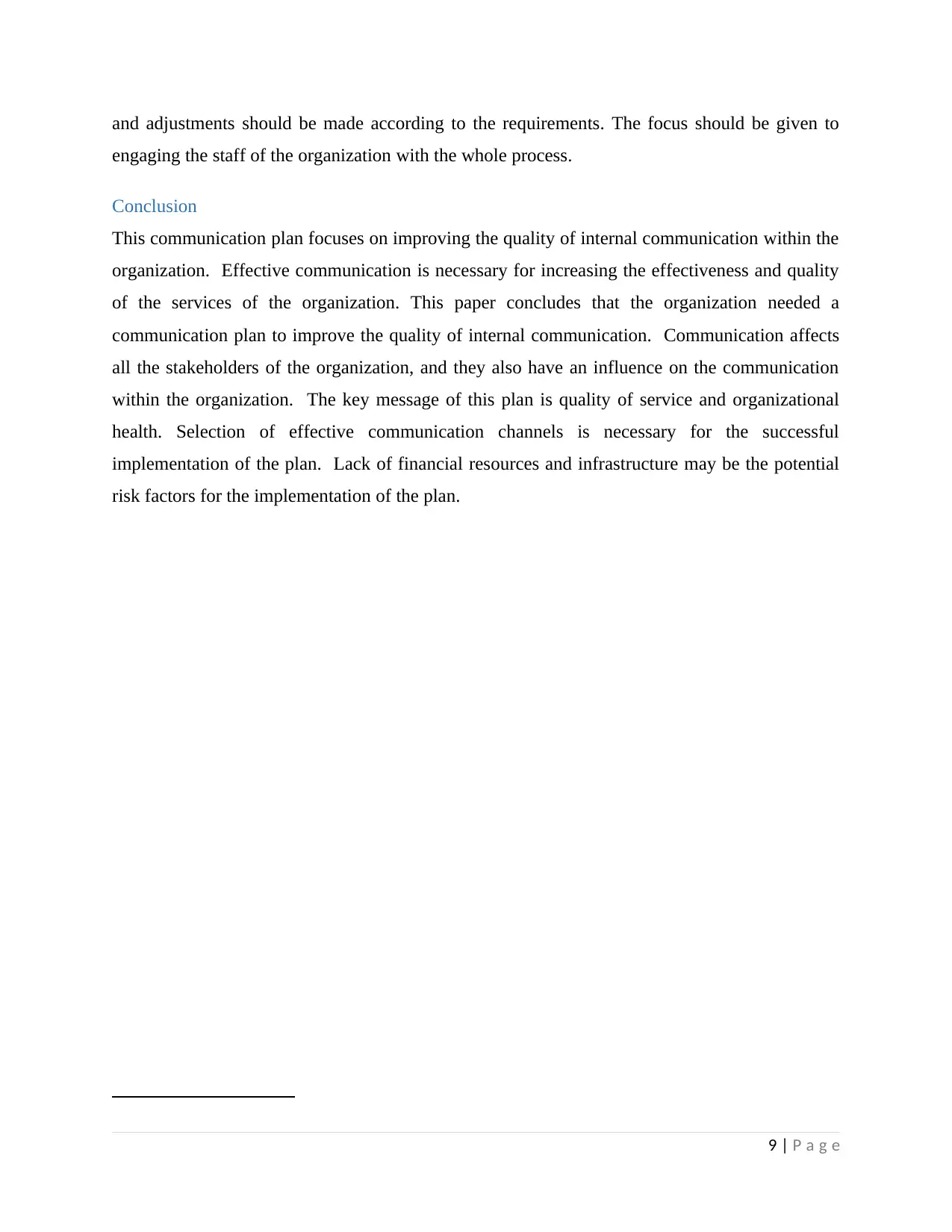
and adjustments should be made according to the requirements. The focus should be given to
engaging the staff of the organization with the whole process.
Conclusion
This communication plan focuses on improving the quality of internal communication within the
organization. Effective communication is necessary for increasing the effectiveness and quality
of the services of the organization. This paper concludes that the organization needed a
communication plan to improve the quality of internal communication. Communication affects
all the stakeholders of the organization, and they also have an influence on the communication
within the organization. The key message of this plan is quality of service and organizational
health. Selection of effective communication channels is necessary for the successful
implementation of the plan. Lack of financial resources and infrastructure may be the potential
risk factors for the implementation of the plan.
9 | P a g e
engaging the staff of the organization with the whole process.
Conclusion
This communication plan focuses on improving the quality of internal communication within the
organization. Effective communication is necessary for increasing the effectiveness and quality
of the services of the organization. This paper concludes that the organization needed a
communication plan to improve the quality of internal communication. Communication affects
all the stakeholders of the organization, and they also have an influence on the communication
within the organization. The key message of this plan is quality of service and organizational
health. Selection of effective communication channels is necessary for the successful
implementation of the plan. Lack of financial resources and infrastructure may be the potential
risk factors for the implementation of the plan.
9 | P a g e
Paraphrase This Document
Need a fresh take? Get an instant paraphrase of this document with our AI Paraphraser
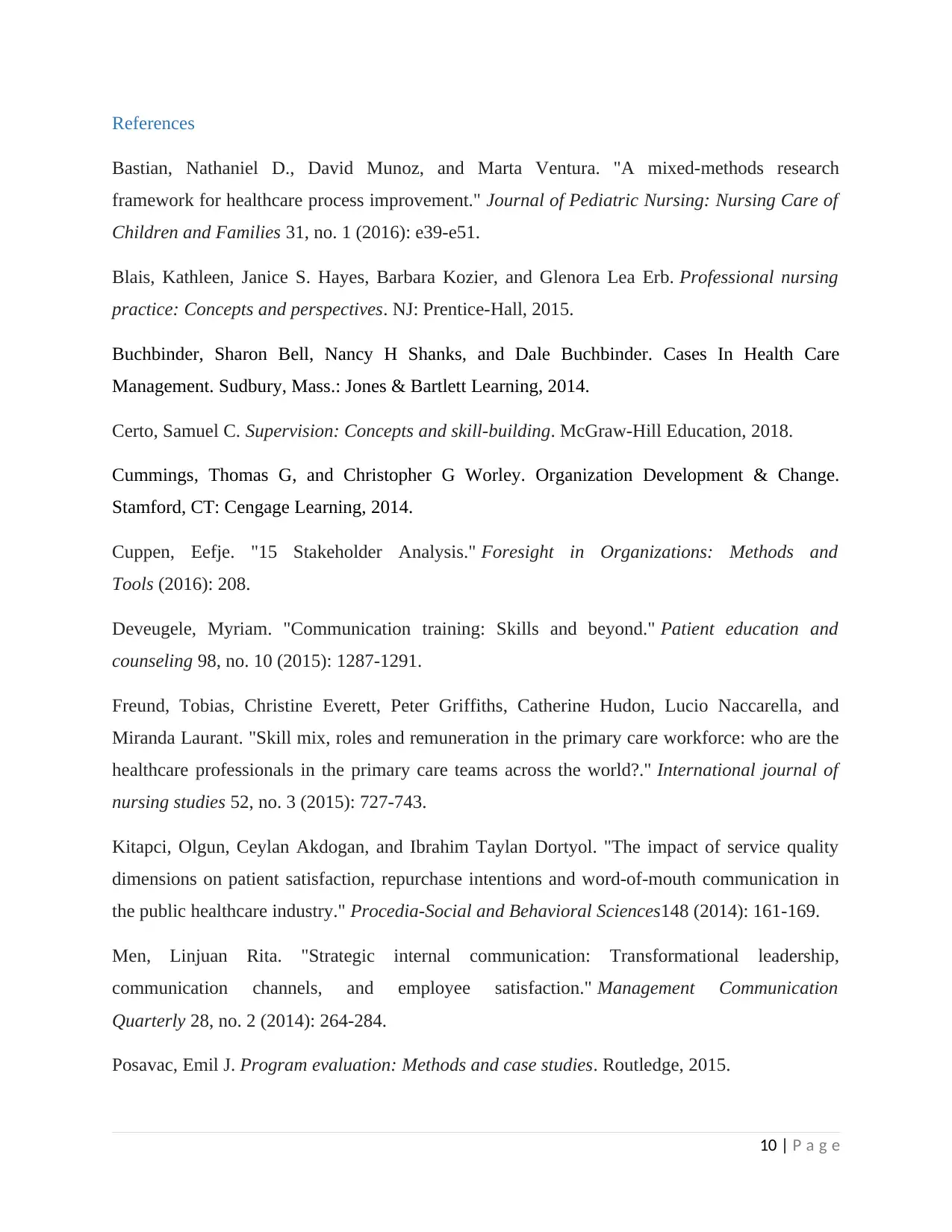
References
Bastian, Nathaniel D., David Munoz, and Marta Ventura. "A mixed-methods research
framework for healthcare process improvement." Journal of Pediatric Nursing: Nursing Care of
Children and Families 31, no. 1 (2016): e39-e51.
Blais, Kathleen, Janice S. Hayes, Barbara Kozier, and Glenora Lea Erb. Professional nursing
practice: Concepts and perspectives. NJ: Prentice-Hall, 2015.
Buchbinder, Sharon Bell, Nancy H Shanks, and Dale Buchbinder. Cases In Health Care
Management. Sudbury, Mass.: Jones & Bartlett Learning, 2014.
Certo, Samuel C. Supervision: Concepts and skill-building. McGraw-Hill Education, 2018.
Cummings, Thomas G, and Christopher G Worley. Organization Development & Change.
Stamford, CT: Cengage Learning, 2014.
Cuppen, Eefje. "15 Stakeholder Analysis." Foresight in Organizations: Methods and
Tools (2016): 208.
Deveugele, Myriam. "Communication training: Skills and beyond." Patient education and
counseling 98, no. 10 (2015): 1287-1291.
Freund, Tobias, Christine Everett, Peter Griffiths, Catherine Hudon, Lucio Naccarella, and
Miranda Laurant. "Skill mix, roles and remuneration in the primary care workforce: who are the
healthcare professionals in the primary care teams across the world?." International journal of
nursing studies 52, no. 3 (2015): 727-743.
Kitapci, Olgun, Ceylan Akdogan, and Ibrahim Taylan Dortyol. "The impact of service quality
dimensions on patient satisfaction, repurchase intentions and word-of-mouth communication in
the public healthcare industry." Procedia-Social and Behavioral Sciences148 (2014): 161-169.
Men, Linjuan Rita. "Strategic internal communication: Transformational leadership,
communication channels, and employee satisfaction." Management Communication
Quarterly 28, no. 2 (2014): 264-284.
Posavac, Emil J. Program evaluation: Methods and case studies. Routledge, 2015.
10 | P a g e
Bastian, Nathaniel D., David Munoz, and Marta Ventura. "A mixed-methods research
framework for healthcare process improvement." Journal of Pediatric Nursing: Nursing Care of
Children and Families 31, no. 1 (2016): e39-e51.
Blais, Kathleen, Janice S. Hayes, Barbara Kozier, and Glenora Lea Erb. Professional nursing
practice: Concepts and perspectives. NJ: Prentice-Hall, 2015.
Buchbinder, Sharon Bell, Nancy H Shanks, and Dale Buchbinder. Cases In Health Care
Management. Sudbury, Mass.: Jones & Bartlett Learning, 2014.
Certo, Samuel C. Supervision: Concepts and skill-building. McGraw-Hill Education, 2018.
Cummings, Thomas G, and Christopher G Worley. Organization Development & Change.
Stamford, CT: Cengage Learning, 2014.
Cuppen, Eefje. "15 Stakeholder Analysis." Foresight in Organizations: Methods and
Tools (2016): 208.
Deveugele, Myriam. "Communication training: Skills and beyond." Patient education and
counseling 98, no. 10 (2015): 1287-1291.
Freund, Tobias, Christine Everett, Peter Griffiths, Catherine Hudon, Lucio Naccarella, and
Miranda Laurant. "Skill mix, roles and remuneration in the primary care workforce: who are the
healthcare professionals in the primary care teams across the world?." International journal of
nursing studies 52, no. 3 (2015): 727-743.
Kitapci, Olgun, Ceylan Akdogan, and Ibrahim Taylan Dortyol. "The impact of service quality
dimensions on patient satisfaction, repurchase intentions and word-of-mouth communication in
the public healthcare industry." Procedia-Social and Behavioral Sciences148 (2014): 161-169.
Men, Linjuan Rita. "Strategic internal communication: Transformational leadership,
communication channels, and employee satisfaction." Management Communication
Quarterly 28, no. 2 (2014): 264-284.
Posavac, Emil J. Program evaluation: Methods and case studies. Routledge, 2015.
10 | P a g e
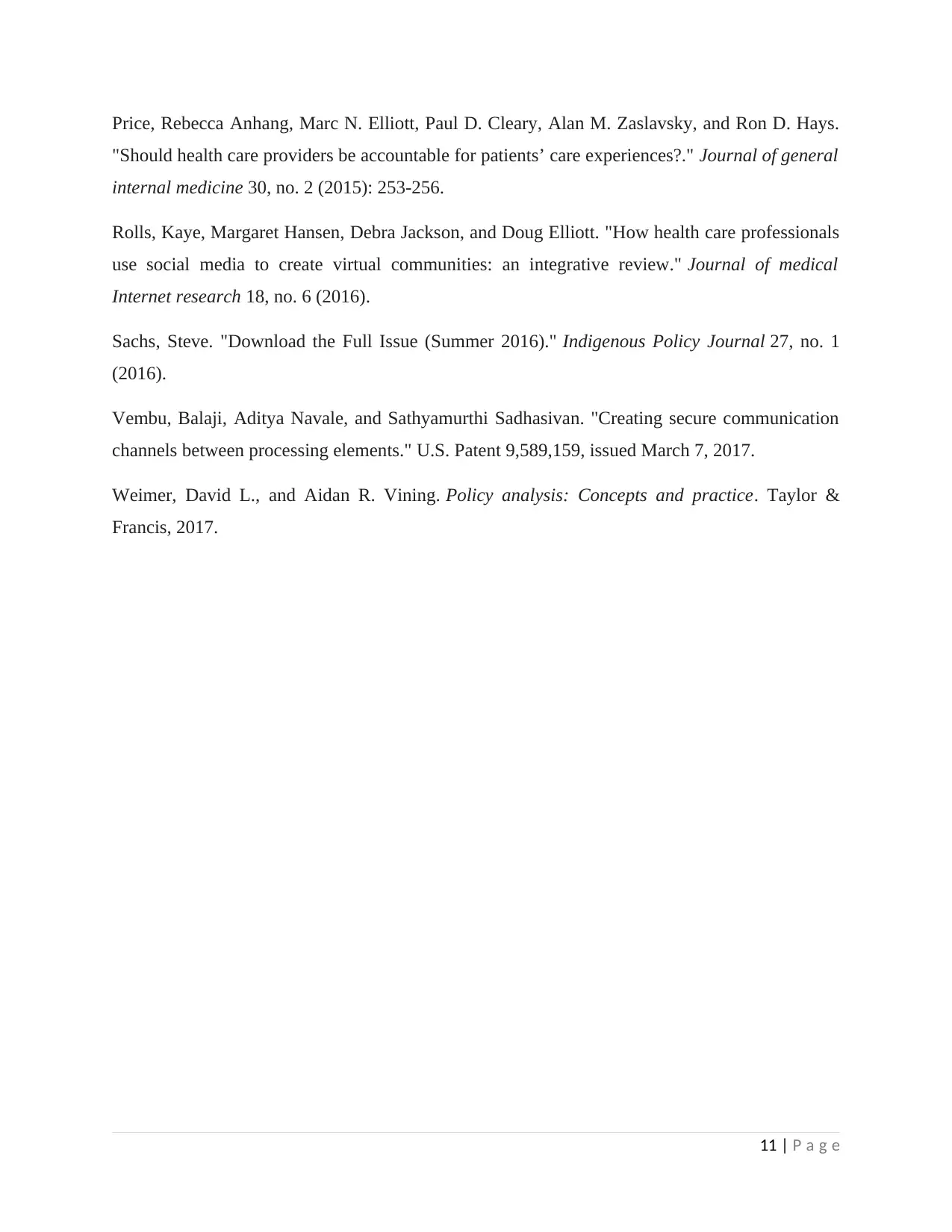
Price, Rebecca Anhang, Marc N. Elliott, Paul D. Cleary, Alan M. Zaslavsky, and Ron D. Hays.
"Should health care providers be accountable for patients’ care experiences?." Journal of general
internal medicine 30, no. 2 (2015): 253-256.
Rolls, Kaye, Margaret Hansen, Debra Jackson, and Doug Elliott. "How health care professionals
use social media to create virtual communities: an integrative review." Journal of medical
Internet research 18, no. 6 (2016).
Sachs, Steve. "Download the Full Issue (Summer 2016)." Indigenous Policy Journal 27, no. 1
(2016).
Vembu, Balaji, Aditya Navale, and Sathyamurthi Sadhasivan. "Creating secure communication
channels between processing elements." U.S. Patent 9,589,159, issued March 7, 2017.
Weimer, David L., and Aidan R. Vining. Policy analysis: Concepts and practice. Taylor &
Francis, 2017.
11 | P a g e
"Should health care providers be accountable for patients’ care experiences?." Journal of general
internal medicine 30, no. 2 (2015): 253-256.
Rolls, Kaye, Margaret Hansen, Debra Jackson, and Doug Elliott. "How health care professionals
use social media to create virtual communities: an integrative review." Journal of medical
Internet research 18, no. 6 (2016).
Sachs, Steve. "Download the Full Issue (Summer 2016)." Indigenous Policy Journal 27, no. 1
(2016).
Vembu, Balaji, Aditya Navale, and Sathyamurthi Sadhasivan. "Creating secure communication
channels between processing elements." U.S. Patent 9,589,159, issued March 7, 2017.
Weimer, David L., and Aidan R. Vining. Policy analysis: Concepts and practice. Taylor &
Francis, 2017.
11 | P a g e
⊘ This is a preview!⊘
Do you want full access?
Subscribe today to unlock all pages.

Trusted by 1+ million students worldwide
1 out of 12
Related Documents
Your All-in-One AI-Powered Toolkit for Academic Success.
+13062052269
info@desklib.com
Available 24*7 on WhatsApp / Email
![[object Object]](/_next/static/media/star-bottom.7253800d.svg)
Unlock your academic potential
Copyright © 2020–2025 A2Z Services. All Rights Reserved. Developed and managed by ZUCOL.




